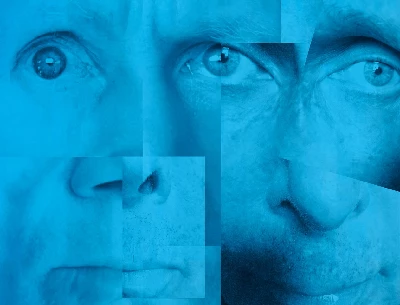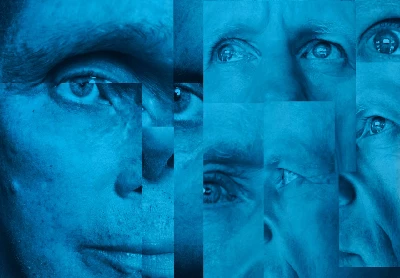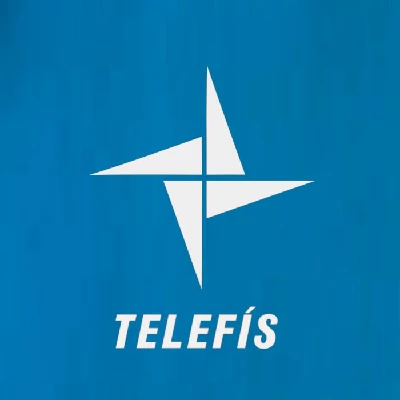Telefis
-
Interview with Jacknife Lee
published: 26 /
11 /
2022

Eoghan Lyng speaks to Jacknife Lee about Telefis’s second and final album Telefís A Do’, collaborating on it with Echo and the Bunnymen’s Will Sergeant and Microdisney’s Sean O’Hagan, and his friendship with his late bandmate Cathal Coughlan.
Article
Jacknife Lee is a busy man. Between production, composition and guitar playing, he's busy promoting Teilfis's sophomore effort, which likely explains why the interview is done over two separate calls. And both calls hold a sombre tone, which is understandable considering that the album is being released only a couple of months after Cathal Coughlan's death. A singer-songwriter of some repute, Coughlan formed Telefís with Lee, which culminated in a collection of records that double as ventures into Irish history as they do as finely crafted pop.
"It's been pretty brutal," Lee sighs. "I knew it was coming, but it happened sooner than I expected. I still can't believe he's gone." I inform Lee that I can relate to the loss, having interviewed Coughlan twice in the past - the latter for Pennyblack - and found him to be a cordial and engaging interviewee. Most pop stars are happy to leave an interview behind them as soon as the phone clicks down, but Coughlan was interested in what I was writing, corresponding in a series of interviews that concluded in a piece I consider to be one of the finest in my short career as a music writer. And the moment the piece went live, Coughlan emailed me to thank me "for all your hard work", which had new resonance when his death was announced earlier this year.
"Yes, that's Cathal," Lee replies. "He was one of the most generous and thoughtful people I've met. He was genuinely concerned with some of the samples I put together, wondering if we had the permission to use them. I told him that everyone, including Gang of Four, was happy to let us use their samples. He was concerned about permission."
Lee lives in America, but he's back in Ireland for the interview - conducted over two days - and says he'd prefer to be in my native Waterford to where he lives, considering the "tarantulas" and "black widows" that populate the area. Lee is best known to this writer for his work with U2, and I'm impressed to hear that the Dublin band have a tendency to leave him "energised", given their far-reaching and insightful nature. “It's impressive at this stage of their career,” Lee explains, “especially when you consider how many bands have tried to follow them, but many of those bands lack the curiosity U2 have or even the understanding of what a collective is. They have to keep exploring, and keep working on the idea seeing what else is in it."
Although he's a few years younger than Coughlan - "I must have been fourteen when I first met him, when he was about twenty" - Lee's worked in the industry long enough to understand that the facade artists present to the outer world isn't necessarily the one they wear in the studio. He considers John Lydon a construct of his own reality ("Some people I went to school with have grown out of that rebellious pushback behaviour, but he doesn't seem to have,"), The Libertines an unfortunate replication of Britain's desire to follow the newest and coolest of trends ("It was bullshit") and suggests that George Harrison's confidence was shook by what the guitarist pencilled was a lack of encouragement by "the two loudest men in the room." "There are times in the ‘Get Back’ series where he comes across as little more than an errand boy," Lee muses. "Maybe that's a bit strong?"
Ultimately, pop stars are often pigeonholed in the decade they helped conquer, which might explain why Lydon still acts like a twenty year old, and Harrison was never able to escape the shy emblem that was awarded to him by his bandmates.
"Cathal was very different to the persona in The Fatima Mansions," Lee elaborates. "He was one of the kindest people I ever met. But over the years, I think his confidence took a hit. He probably felt he wasn't really 'wanted'. It took people we worked with to say that they really liked his stuff."
I suggest that Coughlan was one of the finest lyricists of the post-punk movement. "You can drop 'post-punk' from the sentence," Lee giggles. "Cathal's incredible, and so authentic.”
Furthering the point, he highlights that Coughlan was authentic in a way many artists aren’t: “ Nick Cave and Bob Dylan created personas to write from and eventually became those. Cathal could only be Cathal. He didn’t pretend to be anyone else. He couldn’t.”
Lee can sense I’m a little confused, so he elaborates: “I mean, Nick Cave isn't from the American South as he might like us to believe, and Dylan wasn't from New York, but Cathal's work was so specific to a certain area. A lot of it was oblique, and he didn't necessarily write autobiographical songs, but there were definitely autobiographical elements in there."
Lee does concede that Coughlan was guilty of self-sabotage, especially with some of The Fatima Mansions’ more outlandish material, regularly deviating between moods on songs. But he's clearly an admirer of Coughlan's forward thinking nature, applauding his approach to songwriting. Lee highlights a melody he was working on that he sent over to Coughlan. "I w1as playing and humming something to it. I sent it over to Cathal, and whatever way his brain works, he turned into a song."
The duo worked on two albums, entitled ‘Telefís A hAon’ and ‘Telefís a Dó’ . "I think we liked the idea of the second station," Lee says, explaining why the second album bears a number. "There was RTE One and RTE Two, and BBC One and BBC Two. ‘A hAon’ was delayed because of the vinyl problem. A vinyl shortage isn't the biggest problem in the world, but there was a delay, so we decided to work on an extra track. We sent each over ideas, and then we had four or five on the go."
Lee says he saw something of himself in one of the characters in 'Symphony of Danny La Rue', and felt the second album carried on where the first one left off. "I think in the second album, we were introducing colour. In the Post Lemass period, there was a change in the political prism, and Ireland started looking towards Europe instead of Britain."
‘Telefís A Do’ is accompanied by an essay, written by Stan Erraught - professor of Music and Philosophy at Leeds University – detailing some of the differences between the Irish diaspora and the populus in Britain. Erraught feels the Irish are happy to confine the past to the history books, which is different to England, where young and old pine for the days when their Empire sailed the seven seas. "I saw a video of Mick Jagger and he was making a joke about the showbands," Lee explains. "It was an imperialist thing. In Britain, it's all about being 'cool'. Cathal and I discussed the showbands, and we realised they really weren't that different to us." Musicians need a stage to perform on, whether it's to croon or to roar through the speakers, which might explain Lee's respect for the singers and guitar players who went before him. "There were more similarities than differences, we realised."
Luminaries Rory Gallagher and Henry McCullough learned their trade in the showbands, and, although the music may have seemed quaint against the backdrop of 1970s rock, it did open Ireland to the joys of live music. Lee furthered his music education by listening to Public Image Ltd and Echo and The Bunnymen. Lee sounds positively gleeful discussing the contributions Jah Wobble and Will Sergeant made to Telefís. "Cathal and I remixed 'Falun Gong Dancer', and Jah played bass on it. It's probably our most popular track, but I urge people to go back and listen to the original. My philosophy is just to ask people if they will work with you."
"A lot of them say no," Lee says. "But a lot of the musicians you think might get asked all the time actually aren't. I've copied Jah's style over the years, so I was a bit nervous sending him a dub. He might say, ‘'What the hell is this?' But he sent it back with a bass. He's very proud of his Irish background, and I learned a lot from him. He told us that there's a connection between the East End and Cork, as people would come into the port."
‘Telefís A Do’ boasts an appearance from Sergeant, a guitarist with an encyclopaedic knowledge in rock music. "He came to my place to ask if he could borrow some gear," Lee explains. "And all the way he's looking at my records, saying 'This isn't an original copy; look at the logo.' So, I decide he's giving me permission to ask the fan questions." Sergeant agreed to perform on the track, although the guitarist initially struggled to produce something for the duo. "And then suddenly he comes out with the sound, that Will Sergeant sound. Only he can play the way he does. I don't know if you get that anymore with bands, but even ten years ago, there were bands where you knew who was playing the drums or who was playing guitar based on the sound. And Will has that sound. He has a unique timbre and tone, and I'd love to work with him again in the future."
Between the bass hooks and guitar licks, ‘Telefís a Do’ bristles with a great sense of confidence and cohesion. What drives the album is a combination of melody, memory and mirth. 'The Casiotone Angelus' is awash with the mischievousness and glee that drove Coughlan's past work; 'We See Showbands' commemorates the musicians the tribes of Irish men and women who entertained the isle before Coughlan and Lee got their chance to; and 'Seo É Glór Na Teilifíse' will appease gaeilgeoiri who are determined to hear something that bit more Celtic than English on the airwaves. But if the album can claim a masterpiece, then 'Space Is Us' is the one, rippling with energy and a scintillating guitar solo, performed by Microdisney's Sean O Hagan. "Sean's guitar playing got props from the likes of Johnny Marr, and rightly so," Lee says. "Cathal was a little nervous about asking him to play on the song [Coughlan and O' Hagan worked together in Microdisney, and stayed in touch over the years], but we did. Sean explained that he does more arranging these days, but he played on the track. I love Sean's work: I love The High Llamas and Stereolab."
Lee prides himself on the musicians who worked with the duo, and he explains that he probably will work with them again in the future. But for all the contentment, Coughlan's shadow never leaves. "It's still too early to say what we will do about ‘Teilifís a Trí’ ," Lee explains, but reiterates that Coughlan continued to work until the end. More happily, Lee is happy with ‘Telefís a Do’, highlighting 'Feel The Light' and 'We See Showbands' as two of his favourite tracks. "It has some of my favourite stuff that we've done on it. I'm still a little close and a little modular to it, but I was listening to it since I last spoke to you [between the calls] and I was surprised by some of it. I like it a lot, and I know Cathal did too. In fact, he was thrilled by it."
Band Links:-
https://www.facebook.com/telefis1961/
https://twitter.com/telefis1961
https://telefis.bandcamp.com/album/a-d
Play in YouTube:-
Picture Gallery:-

